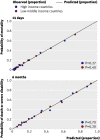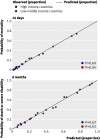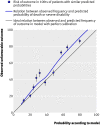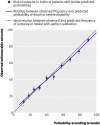Predicting outcome after traumatic brain injury: practical prognostic models based on large cohort of international patients
- PMID: 18270239
- PMCID: PMC2249681
- DOI: 10.1136/bmj.39461.643438.25
Predicting outcome after traumatic brain injury: practical prognostic models based on large cohort of international patients
Abstract
Objective: To develop and validate practical prognostic models for death at 14 days and for death or severe disability six months after traumatic brain injury.
Design: Multivariable logistic regression to select variables that were independently associated with two patient outcomes. Two models designed: "basic" model (demographic and clinical variables only) and "CT" model (basic model plus results of computed tomography). The models were subsequently developed for high and low-middle income countries separately.
Setting: Medical Research Council (MRC) CRASH Trial.
Subjects: 10,008 patients with traumatic brain injury. Models externally validated in a cohort of 8509.
Results: The basic model included four predictors: age, Glasgow coma scale, pupil reactivity, and the presence of major extracranial injury. The CT model also included the presence of petechial haemorrhages, obliteration of the third ventricle or basal cisterns, subarachnoid bleeding, midline shift, and non-evacuated haematoma. In the derivation sample the models showed excellent discrimination (C statistic above 0.80). The models showed good calibration graphically. The Hosmer-Lemeshow test also indicated good calibration, except for the CT model in low-middle income countries. External validation for unfavourable outcome at six months in high income countries showed that basic and CT models had good discrimination (C statistic 0.77 for both models) but poorer calibration.
Conclusion: Simple prognostic models can be used to obtain valid predictions of relevant outcomes in patients with traumatic brain injury.
Conflict of interest statement
Competing interests: None declared.
Figures







Comment in
-
Prognostic modelling in traumatic brain injury.BMJ. 2008 Feb 23;336(7641):397-8. doi: 10.1136/bmj.39461.616991.80. Epub 2008 Feb 12. BMJ. 2008. PMID: 18270240 Free PMC article.
-
Traumatic brain injury: Time of hospital presentation may be important.BMJ. 2008 Mar 8;336(7643):522. doi: 10.1136/bmj.39507.481840.80. BMJ. 2008. PMID: 18325947 Free PMC article. No abstract available.
References
-
- Bruns J Jr, Hauser WA. The epidemiology of traumatic brain injury: a review. Epilepsia 2003;44(suppl 10):2-10. - PubMed
-
- Perel P, Wasserberg J, Ravi RR, Shakur H, Edwards P, Roberts I. Prognosis following head injury: a survey of doctors from developing and developed countries. J Eval Clin Pract 2007;13:464-5. - PubMed
-
- Lee KL, Pryor DB, Harrell FE Jr, Califf RM, Behar VS, Floyd WL, et al. Predicting outcome in coronary disease. Statistical models versus expert clinicians. Am J Med 1986;80:553-60. - PubMed
Publication types
MeSH terms
LinkOut - more resources
Full Text Sources
Other Literature Sources
Medical
